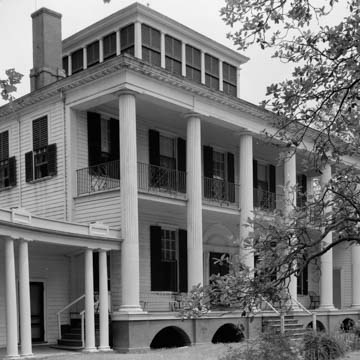Hayes Plantation House is one of the most important Federal period houses in North Carolina, with its Palladian five-part plan, curved hyphens, and double piazza.
Located on the Albemarle Sound just south of downtown Edenton across Little Creek, Hayes consists of a large, two-story central block with a hipped roof topped by a square cupola, plus gabled wings—a kitchen in one, a library in the other—linked by curved colonnades that form a forecourt on the water side. The facade of the main block presents a wide, two-story portico with full-height columns in an order adapted from Stuart and Revett’s Antiquities of Athens. In contrast, the land facade features a small, curved entrance portico with slim columns sheltering a fanlit doorway. Shading the windows and permitting ventilation are unusual louvered blinds. The lower halves swing open like typical shutters while the upper halves swing up like awnings. These, combined with the louvered blinds of the cupola, encourage the breezes from the sound to cool the house in summer.
The interior of the main block follows a central passage plan with the dining and drawing rooms on the land front; they are slightly larger than the rooms toward the rear of the house. Decorative detailing combines Adamesque and early Greek Revival elements, including an arch midway along the central passage that frames the curving stair; the library is decorated in a Gothic mode.
Hayes Plantation House was built during the years 1814–1817 for the well-educated planter James Cathcart Johnston, not his father as previously thought. The plantation was deeded to James in 1814 by his father, the distinguished politician Samuel Johnston, who had named the place Hayes after Sir Walter Raleigh’s home in England. Although the plantation economy and planters’ residences in North Carolina did not rival those of its neighboring states, there were large plantations worked by enslaved people, especially in eastern North Carolina including the area around Edenton. This plantation also included various outbuildings, such as a carriage house and possible slave dwelling, as well as a family cemetery. Other workers’ quarters stood, and some still stand, at a distance from the house.
To plan and manage construction of his large and stylish frame house, Johnston employed the carpenter-architect William Nichols, a native of Bath, England, who had moved from New Bern to Edenton, where he had renovated the colonial St. Paul’s Church. It is likely the design of Hayes reflects ongoing collaboration between a knowledgeable client and his ambitious builder, who was defining himself as architect at a time when professional identities were fluid.
Like many planters in his situation, Johnston took a direct hand in the project, operating essentially as his own contractor, acquiring construction materials beginning in 1814. He employed his enslaved artisans and laborers to accomplish much of the work, supplemented by enslaved artisans he hired from other slaveholders, including bricklayer and plasterer Joe Welcome. Toward the end of the project plasterer Benjamin French arrived from New York to execute the elaborate interior cornices. Johnston also sent Nichols to New York in 1817 to commission specialty items, including stone steps, the fanlight, the mahogany handrail for the stair, and delicate iron porch railings. Nichols also looked for marble mantels in New York but reported to Johnston that he saw none that he thought sufficient.
With Hayes Plantation House completed and with Johnston’s influential support, Nichols went on to other major projects in North Carolina and a position as state architect before leaving in 1827 for Alabama and later Mississippi. James Johnston never married, and he and his unmarried and widowed sisters resided at Hayes until their deaths. James bequeathed the property to his friend Edward Wood, whose descendants have lived at and maintained Hayes to the present.
Still a private residence, the house is visible only from the water and only in winter. Much of the former agricultural land of the plantation, attractively located near the sound, has been developed in recent years. A reproduction of the interior of the Gothic Revival library at Hayes, together with its contents, has been installed at the North Carolina Collection at the Louis Round Wilson Library at the University of North Carolina in Chapel Hill.
The buildings and grounds are not open to the public except for occasional Edenton historic house tours.
References
Bishir, Catherine W. “‘Severe Servitude to House Building’: The Construction of Hayes Plantation House, 1814-1817.” North Carolina Historical Review68, no. 4 (October 1991): 373-408.
Bishir, Catherine W. North Carolina Architecture. Chapel Hill: University of North Carolina Press, 1990.
Hall, Louise. “Architecture.” In The North Carolina Guide, edited by Blackwell P. Robinson, 107-127. Chapel Hill: University of North Carolina Press, 1955.
Zehmer, John G. Hayes: The Plantation, Its People, and Their Papers. Raleigh: North Carolina Office of Archives and History, 2007.

